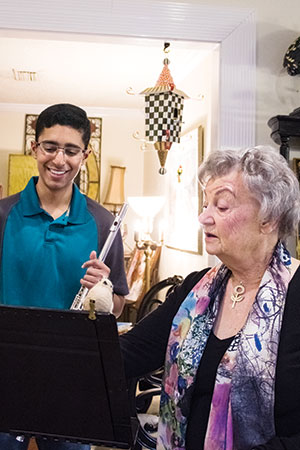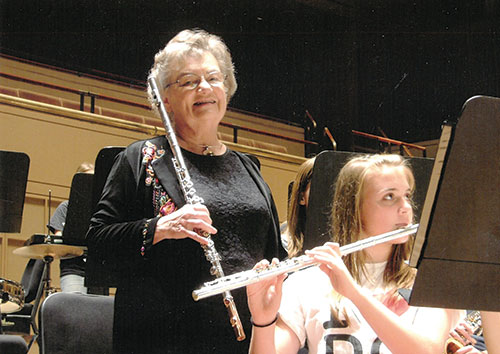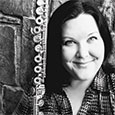Claire Gruneis Johnson was born in New Haven, Connecticut on August 7, 1930 in the middle of the Great Depression. Both her parents were immigrants from Germany. Third born of five siblings, she had two older sisters, a pianist and a violinist, and they performed together as the Gruneis Trio. Their early music education took place at the Neighborhood House Music School, and they were mentioned in the book, They Who Speak in Music: A History of the Neighborhood House Music School by Clarence A. Grimes. After completing high school, she entered The Juilliard School of Music where she studied with Arthur Lora, principal flutist of the NBC Symphony (now the New York Philharmonic).
After graduating from Juilliard, she met and married a young tenor, Ron Johnson. He joined the Navy, and they moved to Kingsville, Texas. She followed her husband’s career in the service from Texas to California to Des Moines, Iowa (where her husband earned his MM in Performance and Music Education from Drake University) to New Jersey and finally to Richardson, Texas. Along the way, she had five children. Building a life in Richardson, Johnson began teaching at Lake Highlands High School and Junior High where she had a great musical partnership with well-known band director Eddie Green. She continued teaching in the Lake Highlands schools as well as dozens of private students even after becoming a flute professor at Southern Methodist University in Dallas, where she taught for thirty-two years. She also taught flute at East Texas State University and, at the age of 65, she added a teaching load at the University of Houston. She would fly to Houston on Mondays and come back home on Tuesdays.
When her husband died on his 40th birthday, she single-handedly raised her five children and took care of two nieces. Today, at the age of 87, she remains active in the flute world and teaches 35-40 hours a week out of her home after retiring from university teaching. She enjoys working with young flute students to build their awareness of beauty and solid fundamental skills from the very beginning.
Johnson was honored with the 2007 Lifetime Achievement Award from the Texas Flute Society and was presented with a collection of letters and stories written by over a hundred flutists and musicians whose lives she has touched. Recently, she was given the 2018 Foundation Award from The Foundation for Music Education and also received a certificate of recognition from the American Protégé Woodwind and Brass Competition after two of her students placed in the competition and were able to perform at Carnegie Hall.
.jpg)
How did you first become interested in music?
The earliest musical experience I remember was with my dad and his brothers, who had just arrived from Germany, sitting around the dining room table singing opera arias. My dad, being from Hamburg, Germany (one of the opera centers of Europe at that time), loved opera and knew many of the arias and art songs of that period. As a young girl, I sang in the choir at a small Lutheran church. There was only one choir, so children and adults sang together. We also sang a lot at home. My two older sisters and I learned solfège at an early age because it was taught at our elementary school. We would sing Christmas carols with solfège, and my mom would ask us to please sing the words.
I started flute in the 4th grade band program. After I played for about six weeks, I told my band director I was ready to move from the beginner class up to the band. I forgot to play B flat, however, so I did not make it. I remember it so clearly. It was my first rejection! The band director said I wasn’t ready. I cried as I put my flute away, trying not to look at the director or the other kids. By the end of the semester, I made it into the band and played first chair, so I showed him.
My next big memory was playing with the New Haven Youth Symphony and the Neighborhood House Music School Orchestra. I was also invited to play in the West Haven High School Orchestra (even though I attended New Haven High School). Since I also played in the New Haven Symphony, I was playing in four orchestras and loved it. I was also an All-State player all four years of high school, but in a small state like Connecticut that was not too difficult.
How did you come to attend Juilliard?
My life has never been a plan, it has been a happening. I followed my best friend Ramona to Juilliard. I remember listening outside the door as she finished the flute lesson before mine with our shared teacher Arthur Schwaner (a piccoloist in the Sousa Band). When Ramona decided to audition for Juilliard, I decided to try as well. I loved being a student at Juilliard and especially liked my theory teacher. When I first began, I realized I was not as great as I thought I was. I always practiced in the farthest practice room so nobody would hear me. Of course, that changed over time. My favorite memory of being a young college student in New York is of performing with composers and other musician friends on street corners in Greenwich Village. We felt cool and performed music because we felt that was what Juilliard students did.
What was life like after you graduated?
I got married, and after my husband joined the Navy, we moved from New York to Texas. There was a lot of culture shock. At that time, cows were still roaming Padre Island. I had moved to a place with only one movie house and one store that sold food, clothes, and horse feed. Of course, Texas has changed incredibly since we first started out in Kingsville. Now, the cultural scene is thriving all over Texas, but especially in Dallas. My husband and I traveled the country, and I took a huge break from flute playing. I took a break from practicing, but never a break from music. Traveling around in the service, we lived in different places and would always rent a piano as soon as we could. Home to me was a piano. When I was young, my mother’s cousin (who was quite wealthy) bought us a piano. That was so important and I have not been in a home without a piano since. Right now, I own a Kawai grand piano and because I have a piano in my home, I can have many recitals and home concerts.
What do you tell your students to increase musical awareness?
I tell them to learn to listen to themselves. Music is not visual, it is aural. Students should have an educated concept of a beautiful sound and constantly work and experiment toward producing that sound. They need to be aware of the body and not interfere with its natural movements.
Look up the word proprioception (the unconscious perception of movement and spatial orientation arising from stimuli within the body) and then improve yours. Relax on the inhalation as you do in a yawn. Let your jaw hang. You need a big space in your mouth. Be aware of what the tongue is doing. Try using carrots, almonds, or corks to put between your teeth (often, you may think you have enough space in your mouth, but you do not). Put your fingers in front of your ears and open and close your mouth so you can feel the spaces at the joint when the jaw hangs. Feel what it is like when the jaw is hanging and in the open position. The jaw has to be relaxed and so does the tongue. Soft tongue, relaxed jaw. The upper lip is 50% of the embouchure, so use it. Even though we only use the upper lip for the letters B, M, and P when we speak, flutists should learn how to use it actively when playing.
Vibrato comes from the cough muscle and sometimes the soft palate. Relax the soft palate to get a darker sound. Vibrato is so nebulous, but there is a place on the soft palate that can help you create a gorgeous, shimmer vibrato. It is worth exploring. Different vowels create different sounds. For example, ee is bright, and ah is warmer. Experiment with tongue shapes and vowel sounds. Do tongue stretches like sticking your tongue out and trying to touch your nose and then trying to touch your chin. Put the tip of the tongue behind your bottom teeth and push the middle through your teeth. Then put the tip behind your top teeth and push the bottom of the tongue through the teeth. Hold the tongue between two fingers and say different vowels without moving the lips. Tongue stretches are very helpful.
Walk around as you practice. Keep moving. Stillness encourages tension. Practice on a yoga ball. Balance starts with the head. It is heavy and weighs 8 to 10 pounds. Don’t allow it to hang forward. Elbows should be neutral. Do not fight gravity. Keep the weight off the lower back and be aware that the diaphragm is attached to the lower spine. Keep the hips free. No tight knees. Study general anatomy, especially the respiratory system. Don’t work for perfection; strive for beauty and get out of your own way. You cannot play the flute beautifully and expressively if you are not aware of beauty.

Rithvik Ramesh with Claire Johnson
As a teacher, who are your flute role models?
Julius Baker has been my biggest role model. Gary Schocker was a student of Baker’s, and I love him and also Emmanuel Pahud. Ian Clarke is also wonderful. The common denominator is freedom in their sound and freedom in their expressiveness. Freedom and singing are essential elements of beautiful flute playing. Skills must be automatic so that you can have freedom and sing through your flute.
What have been some of your favorite teaching and musical experiences over the years?
I learned a lot being the music director for a Methodist church from 1970-1980. I have enjoyed making audiences feel comfortable in masterclasses by using humor. I have done a lot of teaching clinics at TBA, TMEA, and NFA conventions. It was wonderful hosting the Julius Baker masterclasses at SMU from 1986-1992. For years, I enjoyed hosting musical soirées at my house. My living room seats about thirty or so people. We would have a pianist available for reading accompaniments, and flutists would take turns playing for a friendly and supportive crowd. I love having my home filled with music and people. I also enjoy seeing past students succeed including Pam Adams in the Fort Worth Symphony, Peggy Russell-Roubicek in the Houston Ballet Orchestra, Rachel Lopez in the Austin Symphony, and so many others.
.jpg)
Why did you retire from university teaching?
I hit a wall. I found I was not listening to the students the way I had before. I had been teaching at universities for over thirty years and felt I needed to retire. I started teaching exclusively at home and that gives me a lot more freedom. University teaching is an incredible responsibility. Often, students do not realize how much work a career in music takes, and they also do not see the big picture. It is an incredible responsibility to make them aware of all that they must do to create a career in music. When I teach younger students at home, my first job is to help them love music and the flute. I love teaching young students because each one is a new discovery. They are all completely different, and I discover how best to help them learn. There is a lot of creativity involved. I also have many adult students who are interesting, bright people who are willing to learn new things. I have made new friends teaching adult students.
What is the most important thing you want for your students?
I want them to have moments of enlightenment. For example, I was recently at my seven-year-old great grandson’s birthday party. We were singing Happy Birthday to him, and I saw his whole face smile. It was such a sweet moment and is imprinted on my heart. This kind of moment, this kind of connection, is what I want my students to make when they have a moment with beautiful vibrato or a singing sound. I want them to hear the beauty. Clearing your mind and focusing on just one thing like that is a form of meditation. It is what we must do as musicians. It is cleansing. Have you ever read a great book and felt cleaner? Uplifted? Inspired? That’s what I mean.

What are some of the biggest lessons you have learned as a flute teacher?
There is no teaching, only learning. Teaching is a humbling art. I am constantly aware of how much I do not know, and therefore I am constantly searching. My experience at all of the universities where I have taught has been very positive. You have to take each student where they are. The easiest students to teach are those who are open to learning, so I do not have to fight a resistance. I have learned that the first thing to do is to build trust. It is easy for me to build trust with my students because I like people. That is who I am. There has to be no judgment whatsoever, and you have to really believe that. No judgment. Total acceptance. My job as a teacher is to inspire the student, but the student also has the responsibility to inspire me. It is tempting to put everything on the teacher, but students have to practice, they have to question, they have to participate.
I have also learned that if you just give students information, their eyes glaze over. Instead, I ask real questions and require direct and honest answers. I ask questions to cultivate awareness, mindfulness, and connection to beauty. When you teach music to students, you are teaching them openness to life. In music, there is only the search for wholeness and beauty. Music completes a human being in a way that nothing else can.
Ultimately, I would like to be described as a true teacher. Teaching is so big and it is so rich. A true teacher is constantly bringing out the truth of music. Music is never going to die because it has so much truth in it. To get the truth out of a piece of music helps you understand the truth in yourself.
Do you have any advice for young teachers?
Know your stuff! Every student is different. Constantly experiment. Know that what you now know may not be true in five years. Knowledge grows and changes. And you will never know it all.
* * *
Comments from Friends and Former Students
One of the many things I love about Claire is her ability to teach the whole student. With Claire it’s not just about the notes on the page or about playing the flute. Making music is art, culture, politics, education, physiology, psychology, life lessons, and self-expression all beautifully bound together.
– Dr. Kimberly Walter Clark
Studying under Claire Johnson as a young flutist was one of the best things that could ever happen to me. She is so wise and is a master teacher in every way. All of us have something to learn from her. Her attentiveness and care for music is unmatched, and she encouraged me to make every note, and every silence, beautiful.
– Jeemini Lee
Claire is a lifelong learner, with an unquenchable joy in music. Early on in my lessons with her, I learned to expect wide ranging philosophical discussions, book recommendations, and the phrase “I just learned something very interesting…” From Claire, I learned that there is no such thing as “knowing it all.” It took me a long time as a young adult to decide exactly what I wanted to do with my life, but I knew from the first that I wanted to spend my life discovering new ideas like she did. I studied with her from ages 11 to 17, and though I moved on to other teachers and now am a teacher myself, I have never stopped learning from her. These days, having the extraordinary privilege of teaching alongside Claire in several capacities, seeing her always reminds me to express love to the people around me, to seek out new horizons constantly, and to relish music joyfully. – Karen Eichinger
After studying with her from age 12 to 18, I was accepted as a flute student to both Curtis and Juilliard. More than that, she helped a young impressionable, creative mind flourish and grow without ever putting restraints on my temperament. She made me ready to study and grow not only for a career in Texas, but an international one. After playing flute through my 20s, I ended up switching my flute for another voice – my own. I had an international career as an opera and concert singer and her open-minded and all-encompassing approach allowed me to grow beyond what I had even planned for myself.
– Gigi Mitchell-Velasco
Claire continues to be one of my all-time favorite people. Every time we meet I am blown away by some wise tidbit she brought up in conversation. We are extremely lucky to have her in our music community and she challenges us all to become better people.
– Tamara Drury
Claire is more than a teacher. She is a role model, a caretaker, a brilliant thinker, a risk taker, a model of strength. Claire comes up with an idea, says it should happen, includes everyone she can think of to participate, and it happens. It becomes bigger than anyone could have imagined. She is a truly an amazing human being. My life is forever touched and profoundly altered by the knowledge and friendship she has given me.
– Kara Kirkendoll Welch
My journey transitioning from a flutist to an arts administrator reminds me of the hard work and discipline that Claire taught me at a very young age. She told me that music is not about winning. I have to learn the music and then love the music.
– Sandra Wu
* * *
Claire Johnson’s Long Tones Exercise pdf
Long notes should be played with concentration, awareness, and intention. The way one practices is the way one performs. The list on the right contains points on which to individually focus.
Remember, the brain can concentrate on only one thing at a time. Practice long notes with eyes closed. hearing will be enhanced and listening skills will develop.
In exercises 1 and 2, breathe on the bar line. It is important to listen so that the pitches before and after the breath match.
1. Body awareness
2. Breathing
3. Beginning the note clearly
4. Releases
5. Intonation
6. Dynamics
7. Vibrato
8. Color
Originally published in the Floot Fire Books, Intermediate and Advanced.






